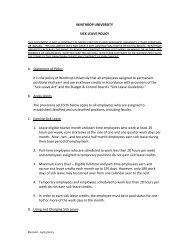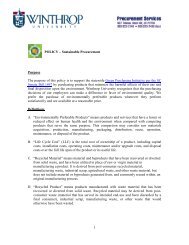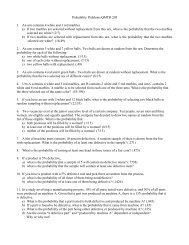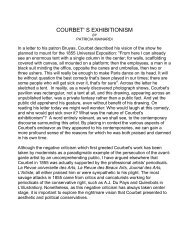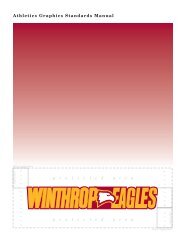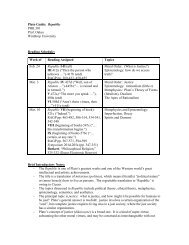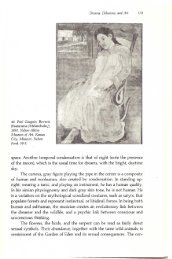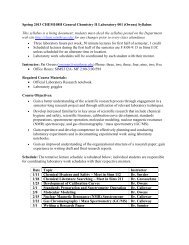Judges Commentary: Snowboarding Course Design - COMAP
Judges Commentary: Snowboarding Course Design - COMAP
Judges Commentary: Snowboarding Course Design - COMAP
You also want an ePaper? Increase the reach of your titles
YUMPU automatically turns print PDFs into web optimized ePapers that Google loves.
The problem examined this year was one of the more difficult problems. Theproblem required that the teams put together a non-trivial physical modeland then apply a variety of mathematical tools in the analysis of the resultingmodel.This overview of the modeling issues is broken up into two parts. Firstthe physics of the various approaches is examined. Then the mathematicsassociated with the various approaches is examined. The majority of theteams used one of two approaches to the physics, and surprisingly the types ofanalysis cannot be easily divided into those two different physics approaches.2.2 PhysicsOne of the difficulties that are a part of this problem is that it requiredthe teams to model nontrivial dynamics. The first task required the teamsto describe the physical situation and describe the terms found within thecomplex equations describing the physical situation.Overall the teams tended to take up one of two different approaches. Thefirst approach made centered on the use of the work-energy relationship, andthe second approach made use of Newton’s Second Law to develop a model.Once an approach had been decided upon the team then had to translate itinto a system of equations. For this second issue the teams made use of awide variety of techniques.2.2.1 Deriving the Physical SituationThe first task for the teams was to describe the physical situation. Thestudents had to describe the physical setup of a snowboarding “half-pipe.”The International Olympic Committee has specific restrictions on the designof a half-pipe, and the majority of teams tried to stay consistent with theOlympic specifications.The majority of teams broke down the construction of the half-pipe intoa small number of parts. For example, a common construction included amiddle flat part down the center of the half-pipe, round corners at the ends,and a flat lip along the top of the sides. Describing those restrictions canbe difficult, and in this case most teams made use of a diagram that greatlysimplified the task of translating those restrictions for the reader.Once the parameters associated with the half-pipe were defined a coordinatesystem also had to be defined. Different teams used different coordinatesystems, and there is no one obvious coordinate system to use. Teams thatclearly indicated the coordinate system and showed it in a diagram hadan immediate advantage when it came to describing the derivation of theirmodel.The parameters for the snow boarder had to be defined. An immediatediscriminator for a paper in this regard was whether or not a free body3
for a team to carefully describe the parametrization and what equation wasused for different portions of the half-pipe.Bringing all of the physical principles together, keeping them consistentfor the whole of path within the half-pipe, translating it correctly into asystem of equations, and then implementing it in a consistent way was anextremely difficult task. Every team’s entry included errors, and some ofthose errors are basic problems dealing with details such as the multivariatechain rule, numerical approximation, or assumptions about the values ofphysical terms.The judges made every effort to try to balance the difficulty of the problemand the short time allotted to the teams the desire to have a clear,correct solution. This not possible in the best of situations, and the judgeshad a difficult task of trying to compare different entries in deciding whichteam put together a better solution. In the end it was a matter of judgment,and the work of the teams that more clearly discussed how they were able toarrive at a conclusion and justify their work tended to make a more positiveimpression on the judges.3 SensitivityThe exploration of the sensitivity of the models tends to mark a significantdifference between the top tier of the submissions and the rest of the entries.Every year the judges expect that the best papers will include some indicationof which parameters are most important and are the most sensitive interms of what happens to the predictions in the presence of small changes invalues of parameters or what happens under slightly different assumptions.This year was no different, and the physical situation offered a rich set ofoptions to explore the sensitivity of the resulting models.In this specific case the sensitivity gives rise to several natural questions.the goal is to determine what happens to the snow boarder’s performancefor small changes to one or more of the parameters. The impact in terms ofboth the height of the jumps and safety for the snow boarders are importantquestions.The exploration can take many forms. The most straight forward approachis to examine small changes in the results when different individualparameters are changed. For example, a team might examine what happenswhen the width of the half-pipe is changed by some small amount.The sensitivity of different parameters is always an important aspect tothe development of a mathematical model. Every year the judges look closelyat this aspect of the problem. Every year very few teams explore this aspectof the problem. A simple way for a team to have their submission standout from the other submissions is to include a coherent exploration of thesensitivity of the mathematical model.5
4 Discussion of ResultsThe majority of the teams that submitted an entry for the “A” problemused one of a few standard approaches. The differences between the entrieswas the combination of techniques used and how extensively the model wasanalyzed. The three things that make an entry stand out and receive positiveattention from the judges are the following: the combination of techniques toassemble a mathematical model, the analysis of the model, and the writingand presentation of the model and results.The first impression that a team can make on a judge come from the waythe material is presented. To make a positive impression a team must providea coherent structure to their document. The summary must be coherent andinclude an overview of the problem, an overview of the paper, and providethe team’s specific results. The document itself should follow some basicrules and maintain a consistent presentation throughout the paper.Some simple rules for any entry can be generalized. The nomenclaturethat is adopted by a team should be clearly described. (Keep in mind differentteams make use of different terms that can make it difficult for a judgeto compare different papers.) Every graph, table, or plot should be clearlydescribed in the text, and the teams should inform the judge what to lookfor and why it is included in the paper. Every equation should be numberedand proper punctuation employed to integrate the equations within the text.A picture can make complicated ideas much easier to understand. A freebody diagram and a clear picture that shows the coordinate system can makeit much easier for a judge to determine what a team was able to accomplish.When a plot is used the axes should be clearly labeled and the units stated.Just having a table of contents at the beginning of the document can makeit much easier for a judge reading a paper in the early rounds.Finally, team members should know the difference between a citationand a reference. The references are the list of sources that are included atthe end of the document and are a vital addition to a paper. Citations arethe indications within the text that help the reader decide which referenceare associated with specific ideas. A vast number of entries include a listof references but do not include citations within the text. Simply includingconsistent citations is an easy way to make a team’s entry stand apart fromthe other entries.5 ConclusionsThe “A” problem for this year was a difficult problem. Determining the importantparameters and designing a half-pipe for snow boarders is a challengethat required the teams to bring together complex physics principles usinga wide array of mathematical topics. Every team was unable to avoid some6
asic pitfalls, but most of the submissions reflected the team’s overall desireto complete an excellent submission for this event.The majority of teams made use of similar physical principles, but thedifferent ways that those principles were applied and translated into a mathematicalmodel made the difference between the different submissions. Thejudges were aware that this is a difficult problem, and the teams had a limitedtime to explore the topic. Despite these difficulties, the teams wereable to bring together a high level of talent and desire that resulted in animpressive collection of entries.In the end the difference between the papers judged to be the top entriescame down to the analysis of the subsequent models and the way in whichthe teams conveyed their results.7



